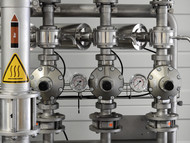The Difference Between Pressure and Flow
Posted by AVP on Mar 27th 2021
The terms pressure and flow are two of the more common terms you’re certain to encounter when talking about compressed air systems. Pressure and flow are critical measurements for any compressed air system as they help in the sizing of compressors to power applications with sufficient air volume and flow rate.
What’s pressure?
Pressure is simply a measure of force that’s given to an area. For a compressor it helps determine the ability to perform a certain amount of work at a given point in time. The compressor must be able to provide the right amount of pressure, or force, needed to complete the specific process. If there is not enough pressure that can prevent the job from getting done. Too much pressure can cause damage to the equipment or cause an unforeseen malfunction.
The way pressure is Measured?
The acronym for the pressure created is PSI and stands for pounds per square inch. 40 psi stands for there being 40 pounds of pressure being applied per square inch. The air gauge on your compressed air system will display the PSI output on the system.
What is Flow?
Flow is the measure of volume that provides the output rate of the compressor system. This flow rate helps determine the compressor’s ability to continue performing a task. The flow rate needed mainly depends on the period of time required to complete the task. If the flow rate is insufficient, the compressor will probably need periodic breaks to regain pressure in the compressor’s reserve tank.
How is Flow Measured?
As PSI is the acronym for the measurement of pressure, CFM stands for cubic feet per minute and is the measurement for flow and correlates to the power applied. With this in mind it is easy to see the difference in the common air compressor and the industrial air compressors and why they can achieve much higher CFM.
How does Pressure and Flow work together?
Knowing what the measurements PSI and CFM are will now allow us to understand better how they work together to impact a specific task. In order to perform a task at an efficient level, the proper airflow (CFM) and pressure (PSI) must exist or the task may not be able to be accomplished.
Let’s say we need 50 psi to move an object from point A to point B. If you only have 40 psi the object may not move. If you have the correct psi, 50, for this example, but the airflow is low then there may not be enough capacity to move the object all the way to point B. In this case the size of the compressor and/or tank may not be enough to hold and maintain enough airflow to continually move the object to point B causing the task to take more time than if the compressor is greater allowing a continuous airflow.
Overpressurization can be an issue.
Be cautious of overpressurizing your compressed air system. Understanding the application’s required pressure and flow can sometimes be difficult. Overpressurizing the system by increasing the system’s pressure in order to make sure processes run consistently may results in severe energy losses and high energy costs.
The Takeaway
It is important to understand the task that is being performed and your compressed air system to make sure you have the correct pressure and flow to safely and efficiently accomplish your goal.
Here are a few of our current favorite compressors:
- PC106 Panther Oil Free Mini Air Compressor, 1.57 Gallon Tank, Silencing Cabinet, 4.4 CFM, 115/1/60
- PC2/50, Panther Oil Free Mini Air Compressor, 13 Gallon Tank, 6.35 CFM, 115/1/60
- PC2x2/100, Panther Oil Free Mini Air Compressor, 26 Gallon Tank, 12.7 CFM, 220/1/60PC5x2/500, Panther Oil Free Mini Air Compressor, 130 Gallon Tank, 55 CFM, 208-240-460V/3Phase
- PC5x2/500, Panther Oil Free Mini Air Compressor, 130 Gallon Tank, 55 CFM, 208-240-460V/3Phase
Trust the Experts
At AVP, we know a thing or two about air compressors. Call us for an expert recommendation at (281) 866-9700 or check out our store at shop.airvacuumprocess.com.
